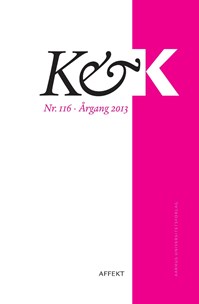BEVIDSTHED I BEVÆGELSE - OM DEN JAPANSKE FORFATTER NATSUME SŌSEKIS SANSEBEVIDSTHED
DOI:
https://doi.org/10.7146/kok.v41i116.15890Nøgleord:
Sōseki, modern Japanese literature, stream of consciousness, affect, embodiment, serialization, everyday aesthetics, representationResumé
CONSCIOUSNESS AS MOVEMENT — ACCORDING TO NATSUME SŌSEKI | In his Theory of Literature from 1907, Japanese writer Natsume Sōseki (1867‑1916) describes feelings as pivotal in literature worldwide. Fredric Jameson places Sōseki among the major modernists in the twentieth century. Like the western modernists, Sōseki was inspired by William James’ concept stream of consciousness, developing his own idea about literature as an affective type of continuity of consciousness. This article investigates how this idea influences the representation of characters in his last, unfinished feuilleton novel, Light and Dark from 1916. The article argues that a comparison with current day affect theory calls attention to how Sōseki not only portrays the bodily emotions, but also consciousness as embodied and embedded in particular social spaces. In this novel Sōseki depictsor sketches minor feelings or everyday affects as closely related to the experience of modernity. By exploiting its feuilleton form, Light and Dark shows how new modes of perception and movement
produce affects that stick to bodies (rather than spring from them). The article thus suggests seeing Light and Dark as a critical and nuanced comment on modernity and its discourses on emotions.
Downloads
Citation/Eksport
Vilslev, A. T. (2013). BEVIDSTHED I BEVÆGELSE - OM DEN JAPANSKE FORFATTER NATSUME SŌSEKIS SANSEBEVIDSTHED. K&K - Kultur Og Klasse, 41(116), 63–75. https://doi.org/10.7146/kok.v41i116.15890
Nummer
Sektion
Artikler
Licens
Tidsskriftet følger dansk ophavsret.





